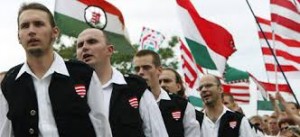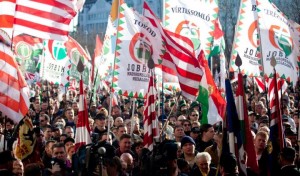Note from the LeftEast editors: This article has been adapted for LeftEast from the original in Eszmélet 105. Follow the link to read PART II: ‘National rejuvenation’ and ‘social justice’: the ideology and praxis of Jobbik
PART 1: From right –wing movement to the third force in Hungarian politics: Jobbik’s ascendence 1999-2010
 In recent years, Hungary has become a symbol of a wider rightward shift in Europe. A plethora of paramilitary organisations, many of whom are explicitly drawing on the symbolism of the infamous Arrow Cross, the Hungarian Nazis responsible for the murder of tens of thousands of Jews in the encircled Budapest of 1944-45, march up and down streets around the country, threatening minorities. Meanwhile, in less than ten years, the fascist Jobbik party has gone from being a small, relatively unknown student movement, to become the second most popular party in opinion polls and a serious influence on the authoritarian policies pursued by Viktor Orbán’s neoconservative FIDESZ government since coming into power in 2010.
In recent years, Hungary has become a symbol of a wider rightward shift in Europe. A plethora of paramilitary organisations, many of whom are explicitly drawing on the symbolism of the infamous Arrow Cross, the Hungarian Nazis responsible for the murder of tens of thousands of Jews in the encircled Budapest of 1944-45, march up and down streets around the country, threatening minorities. Meanwhile, in less than ten years, the fascist Jobbik party has gone from being a small, relatively unknown student movement, to become the second most popular party in opinion polls and a serious influence on the authoritarian policies pursued by Viktor Orbán’s neoconservative FIDESZ government since coming into power in 2010.
The spectacular rise of Jobbik in recent years has led to a growing number of studies, predominantly by scholars from mainstream political science, which have sought to analyse and explain this phenomenon. Most tend to associate the party’s rise with the strengthening of anti-Roma sentiments in the wake of a number of tragic murders, committed by people with Roma origins, in the winter of 2006. They also tend to agree that the establishment of the Hungarian Guard (Magyar Gárda) – a paramilitary organisation with close ties to Jobbik – was crucial for the party’s success; it sparked media attention in supposed ‘Gypsy crime’ and enabled the party to present itself as a legitimate force of ‘law and order.’ Meanwhile, others, whilst acknowledging that anti-Roma racism and the Hungarian Guard were important factors behind the initial success of Jobbik, argue that the party’s ability to not only retain, but strengthen support after the 2009 European Parliament (EP) elections was dependent on a number of other factors, including: 1) the deepening crisis of the socialist-liberal MSZP-SZDSZ coalition from 2006 onwards and a wider lack of trust in democratic institutions; 2) the negative impact of global economic crisis on Hungarian society; 3) the internal reorganisation of Jobbik following the election of the young and wily Gábor Vona as party leader in 2006; and/or 4) the ability of Jobbik to offer a coherent political programme promising to alleviate Hungary’s deepening economic problems caused by ‘neoliberal globalisation.’

While the above accounts have provided interesting insights into Jobbik’s origins, political discourse, and the social composition of its supporters, I argue that they remain empirically and theoretically problematic, as well as limited in scope. Drawing on the work of Italian Marxist Antonio Gramsci, in combination with careful analysis of key party documents and political actions, I present an alternative account by tracing the key factors behind Jobbik’s ascendancy to broader, socio-economic and politico-ideological transformations in Hungarian society since the formal transition to a (free) market economy and liberal democracy in 1989-90. The main argument is that the secret behind the party’s success derives, to a large extent, from its ability to construct a ‘counter-hegemonic bloc’ against the injustices wrought by neoliberal capitalism. Through pseudo-revolutionary demands (e.g. opposition to transnational corporations and political corruption, nationalisation of the banking sector, etc.) and defiant attitude towards institutions of neoliberal capitalism (cf. the burning of the EU flag at a demonstration in Budapest in 2012), the party has been able to present itself as an ’anti-systemic’ political force, reaching beyond traditional far-right voters and making significant inroads among young, relatively well-educated people, frustrated with the ‘failures’ of the regime change, and afraid of becoming déclassé.
The genesis of Jobbik
Although Hungary has a long and violent history of far-right politics, dating as far back as the early 20th century, the origins of Jobbik date back to 1999, when a group of national-conservative university students based at the Eötvös Loránd University in Budapest formed the Right-wing Youth Community (Jobboldali Ifjúsági Közösség, JIK). At the time, many of the association’s leading figures were politically active in István Csurka’s Hungarian Justice and Life Party (Magyar Igazság és Élet Pártja, MIÉP), the largest far-right party at the time with 14 seats in the Hungarian Parliament. Others, including current party leader Gábor Vona, held more ‘moderate’ views and sympathised with FIDESZ, the largest party of the national-conservative coalition in power between 1998-2002.

However, the members of JIK would soon become disillusioned with both parties. They felt that MIÉP was under the autocratic control of Csurka, whose simplistic conspiracy theories of ‘Judeo-Bolshevik plots’ against Hungary and outdated political activities were unable to appeal to young voters with nationalist sympathies, or people in the countryside, and thus did not offer any prospects for the future. Similarly, they were unimpressed by Viktor Orbán’s attempt to rejuvenate and unite the Right under one banner (led by FIDESZ) through the creation of a nationwide national-conservative movement centered in ‘bourgeois circles’ (polgári körök). As Vona stated at the time, ‘For Jobbik, the vision of [establishing] a bourgeois Hungary [employed at the time by FIDESZ] is not enough. … We want a national vision, a national programme, and, most of all, we want actions.’ Seeking to turn these ideas into reality, Jobbik was formally established as a political party in October 2003 with 1,200 self-proclaimed members.
According to its founding manifesto, the party described itself as a ‘conservative, radical, national-Christian party’, whose aim was, ‘to complete’ the regime change of 1989 and ‘to create a better and more just society.’ Initially, the party sought to gain public attention through a number of provocative campaigns, openly challenging the liberal values on which the Hungarian republic had been constructed after 1989. These included the erection of Christian crosses on central squares throughout Hungary during Christmas 2003 (‘in order to draw attention to the original Christian message of the holiday’), the defamation of a plaque raised in memory of the anti-fascist martyr Endre Ságvári in early 2006, and the initialisation of a campaign, later that year, seeking to ‘rehabilitate’ the Árpád-flag, the coat of arms of the mediaeval Árpád kings, used by the Nazi Arrow Cross during the interwar years, which reappeared with increasing frequency at anti-government protests during the autumn of 2006. Having declined to participate in the 2004 EP elections (in protest of Hungary’s ‘premature accession to the EU’), Jobbik decided to form an electoral alliance with MIÉP in the 2006 general elections. However, the coalition only obtained 2.2% of the votes and failed to get into parliament. The alliance was broken shortly afterwards following internal disagreements. Despite being largely comprised by a young membership and engaging in a number of media-savvy activities, Jobbik thus remained a marginal force in Hungarian politics in 2006.
The ‘organic crisis’ of Hungarian capitalism and the ascendancy of Jobbik

Jobbik’s first major electoral breakthrough took place in the 2009 EP elections, in which the party arrived third, with 427,773 votes (14.77 %), enabling it to send 3 representatives to the European Parliament and shaking the Hungarian political establishment. Rather than a one-off event (an unnatural disturbance to ‘ordinary’ bourgeois politics), this was a sign of a wider, rightward shift in Hungarian politics in the wake of the ongoing economic, political, social crisis, and the ascendancy of Jobbik as a pole of attraction for far-right voters disenchanted with the status quo of mainstream politics. In the 2010 general elections, the party doubled its electoral support (855,436 votes), obtaining 16.67% of the votes, and 47 seats in parliament.
What then explains the spectacular rise in popularity of Jobbik between 2006-10? This phenomenon cannot be attributed to individual factors alone (i.e. mounting anti-Roma racism in wider society or the employment of what Mireanu describes as a ‘logic of spectacle’, through the deployment of the Hungarian Guard, in order to legitimise policies of ‘law and order’).It needs to be understood in the context of the deep economic, political and social transformations that have shaken Hungary since the regime change in 1989-90. In this sense, the ascendancy of Jobbik is arguably not an exception to developments elsewhere, but rather symptomatic of a broader political shift to the right in Europe (and elsewhere), which has become particularly discernable in the ongoing global economic crisis.
The neoliberal restructuring of the former Soviet bloc economies turned out to be a nightmare for the overwhelming majority of people in the region. While restructuring produced some individual success stories, including former nomenklatura-turned entrepreneurs who made fortunes buying and selling western cars and consumer goods, or selling off previously state-owned enterprises to transnational corporations, it deepened class and regional inequalities and strengthened social antagonisms both within and between states. The arrival of transnational capital, new technologies, and the gradual transition towards a post-Fordist economy, based on finance and services, rendered existing skills and infrastructure obsolete and many unskilled workers redundant. In Hungary, more than 1.3 million jobs (almost 1/3 of the entire workforce!) disappeared during the first five years of transition, while structural adjustment measures introduced between 1988-95 destroyed more economic assets than did World War II.
The entrenchment of mass unemployment led to declining living standards and formation of a new ‘underclass’, comprised of permanently unemployed people lacking proper access to health care, education, and social security. Hence, by the early 2000s the class composition of Hungary was becoming reminiscent of the interwar Horthy era, when a small ruling class of aristocrats, large landowners, and the gentry dominated society, while ‘three million beggars’ lived in penury at the bottom end of society. In addition to increasing class and regional inequalities, neoliberal reforms strengthened social antagonisms. The Roma, who constitute Hungary’s largest ethnic minority (3.2% of the population according to the 2011 census), were hit disproportionately hard by increasing precarisation, with unemployment and poverty rates skyrocketing in the mid-1990s. While the new underclass became increasingly dependent on welfare provisions for survival, state spending on welfare and social protection was cut by successive governments in Budapest across the political spectrum. This was accompanied by an increasingly explicit and formalised stigmatisation of the poor, demonised in public discourse as ‘lazy’ and ‘undeserving’. The new, hegemonic worldview of Hungary’s new ruling class was bluntly summarised in 2011 by influential FIDESZ politician János Lázár, as follows: ‘he who has nothing, is only worth as much’.
By the early 2000s, the material foundations sustaining what neoliberal economists mockingly described as Hungary’s ‘premature welfare state’ were quickly drying up. On the one hand, privatisation revenues were rapidly diminishing, as most of the Hungarian manufacturing and services industry had already been sold off to transnational corporations. On the other hand, attracting additional foreign investments was becoming increasingly difficult due to growing inter-state competition,within the region and globally, following the rapid rise of China as the new ‘workshop of the world’. Faced with increasing pressures at home and abroad, the socialist-liberal government abandoned its promise of a ‘welfare regime change’ (jóléti rendszerváltás) and replaced the lacklustre, non-partisan Prime Minister Medgyessy with Ferenc Gyurcsány, a young multi-millionaire and an ambitious pro-reformer. Drawing inspiration from Anthony Giddens and Tony Blair’s ‘Third Way,’ he attempted to transform MSZP from an ‘outdated’, ‘reform communist’ party into a ‘modern’, ‘social-democratic’ party promoting economic and political reforms ‘from above’, while remaining sympathetic to ‘social justice’ and ‘equal opportunity.’ Initially, Gyurcsány’s approach seemed to be successful, as the socialist-liberal coalition won the 2006 general elections, thus becoming the first ‘post-communist’ government in Central and Eastern Europe to win re-election. However, this victory turned out to be pyrrhic.
Having won the elections on a slogan of ‘reform without austerity’, Gyurcsány was quickly forced to introduce radical austerity measures in order to stay within the narrow boundaries of the Maastricht criteria. As a result, the socialist-liberal government’s popularity quickly plummeted. Things then got worse: following revelations of a secret speech to the MSZP’s parliamentary faction, in which Gyurcsány, using particularly obscene language, admitted that his government had ‘lied morning, noon, and night’ in order to win elections earlier in the year, anti-government protests erupted in Budapest, on a scale unprecedented in the brief history of the young Hungarian democracy. As large-scale anti-government protests continued in Budapest and other major cities until the end of 2006, public opinion polarised and shifted to right. Having played an active role in the demonstrations, Jobbik gradually transformed the party’s image from a marginal, far-right party to a radical, nationalist force, which stood up for ‘spiritual and material interests of the Hungarian nation’ against the ‘illegitimate’ and ‘nation-destroying’ (nemzetromboló) socialist-liberal coalition.
As the country’s economic malaise deepened following onset of the global economic crisis, public disillusionment and outright anger with liberal democracy intensified, leading to a rapid decline in support for the parties of ‘centre-left’ and a steady rise of the Right. A 2009 comparative survey provides a striking indication of the level of public dissatisfaction with the current state of affairs: A stunning 94% of Hungarians interviewed regarded the economic situation in the country as ‘bad’, while 72% said they were ‘worse off now than under Communism’. Moreover, more than 3/4 (77 %) were ‘dissatisified’ with the way democracy was working in their country, compared to 49% of respondents in the Czech Republic, 46% in Slovakia, and only 39% in Poland. The study also showed an increasing opposition to EU membership 28% responding that it was ‘a bad thing’. Under such conditions Hungary’s economic crisis was arguably extending beyond the boundaries of a ‘cyclical crisis’ (i.e. a normal downturn in the capitalist business cycle), to what Gramsci described as an ‘organic crisis’, in which the hegemony of neoliberal capitalism was at stake.
Faced with the dual pressures of economic crisis and a crisis of its own legitimacy the socialist-liberal government attempted to free itself from the representative structures and rules of parliamentary democracy (a process described by Gramsci as ‘Caesarism’ or ‘Bonapartism’, in which ‘a great historical personality is entrusted with the task “arbitration” over a historico-political situation characterised by an equilibrium of forces heading towards catastrophe’). However, in absence of a Caesar or Napoleon Bonaparte of their own, the MSZP opted to replace the widely despised (albeit popularly elected) Gyurcsány with a semi-technocratic government headed by the young, but uncharismatic Gordon Bajnai. In addition to the introduction of another round of austerity measures, the new government initiated a process of disengagement with civil society and trade unions, while simultaneously strengthening a discourse of a ‘law and order’ and introducing a workfare programme. While the Bajnai government’s measures managed to steer the Hungarian economy away from the risk of bankruptcy the socialist-liberal coalition was trounced in the 2010 general elections.
The ascendancy of Jobbik has thus been intertwined with broader economic, political, and social transformations in Hungarian society. Jobbik represents the latest and most regressive configuration of a wider reactionary backlash wrought by neoliberal restructuring since 1989 in Hungarian society. In part II, we will first look in detail at the ideas and practices employed by Jobbik in order to construct a ‘counter-hegemonic bloc’ promising to defend ‘ordinary Hungarians’ against the ravages of neoliberal capitalism, and then examine the party’s political trajectory in the current conjuncture and prospects for anti-fascist resistance.
All sources can be found at the end of the Hungarian Language original here.
 Adam Fabry is a political economist and activist. He is currently based in Córdoba (Argentina), where he does research on the economic- and social history of neoliberalism in Latin America and Eastern Europe and the history and politics of the far right in Hungary and elsewhere. His publications include: ‘The Far-right in Hungary’ (in The Far-right in Europe, edited by Fred Leplat and forthcoming later this year with Resistance Books and Merlin Press) and ‘From poster boy of neoliberal transformation to basket case: Hungary and the global economic crisis’ (in First the Transition then the Crash: Eastern Europe in the 2000s, edited by Gareth Dale and published by Pluto Press in 2011). He is also the editor of From the Vanguard to the Margins: Workers in Hungary, 1939 to the Present (Brill, 2014) and the co-editor (together with Richard Saull, Alexander Anievas and Neil Davidson) of The Long Durée of the Far-Right: An International Historical Sociology (Routledge, 2014)
Adam Fabry is a political economist and activist. He is currently based in Córdoba (Argentina), where he does research on the economic- and social history of neoliberalism in Latin America and Eastern Europe and the history and politics of the far right in Hungary and elsewhere. His publications include: ‘The Far-right in Hungary’ (in The Far-right in Europe, edited by Fred Leplat and forthcoming later this year with Resistance Books and Merlin Press) and ‘From poster boy of neoliberal transformation to basket case: Hungary and the global economic crisis’ (in First the Transition then the Crash: Eastern Europe in the 2000s, edited by Gareth Dale and published by Pluto Press in 2011). He is also the editor of From the Vanguard to the Margins: Workers in Hungary, 1939 to the Present (Brill, 2014) and the co-editor (together with Richard Saull, Alexander Anievas and Neil Davidson) of The Long Durée of the Far-Right: An International Historical Sociology (Routledge, 2014)

